Her Majesty's Prison Service

Her Majesty's Prison Service is a part of the National Offender Management Service of Her Majesty's Government tasked with managing most of the prisons within England and Wales. (Scotland and Northern Ireland have their own prison services: the Scottish Prison Service and the Northern Ireland Prison Service, respectively.)
The Director-General of the National Offender Management Service, currently Michael Spurr, is the administrator of the prison service. The Director-General reports to the Secretary of State for Justice and also works closely with the Prisons Minister, a junior ministerial post within the Ministry of Justice.
It has its head office in Clive House.[1] It formerly had its head office in Cleland House in the City of Westminster, London.[2]
The British Overseas Territory of Bermuda's HM Prison Service (renamed the Department of Corrections in 2002) was a separate organisation.
Operation
In 2004, the Prison Service was responsible for 130 prisons and employed around 44,000 staff. As of 2009 the number of prisons had increased to 131, including 11 privately owned prisons.[3]
The Service's statement of purpose states "Her Majesty's Prison Service serves the public by keeping in custody those committed by the courts. Our duty is to look after them with humanity and help them lead law-abiding and useful lives in custody and after release." The Ministry of Justice's objective for prisons seeks "Effective execution of the sentences of the courts so as to reduce re-offending and protect the public".
Population statistics for the Service are published weekly. Statistics available for 24 June 2016 showed the service housed 85,130 prisoners: 81,274 males and 3,856 females.[4]
The over 60's are the fastest growing age category and Professor David Wilson, of Birmingham City University is concerned that there is no strategy to deal with them.[5]
Reform
Early in 2004, it was announced that the Prison Service would be integrated into a new National Offender Management Service later in the year.
As of 2008, rationalisation of the prison management system is underway with the advent of the Titan Prison concept.
Six new reform prisons are to be built with prison governors in charge of operation and budget. Penal charities claimed reforms would fail if prisoners were "crammed into filthy institutions with no staff".[6]
Criticism
In 2015 the Justice Select Committee, following a year long prison inquiry, were critical of Justice ministers for apparent complacency about a 38% rise in prison deaths since 2012. The committee concluded that efficiency savings and staffing shortages had made "a significant contribution to the deterioration in safety" in prisons.[7][8] A prison "benchmarking" programme had been introduced in 2012 by Justice Secretary Chris Grayling to reduce the costs of of public sector prisons to match comparable private sector prisons, along with associated new core standards intended to result in prisoners having similar amounts of time spent outside their cells across similar prisons.[9] Prison officer numbers had been reduced from about 23,000 in 2012, already reduced from about 25,000 in 2010, to about 18,000 in 2015.[10]
Prisons are overcrowded and understaffed leading to riots, prison escapes and poor supervision of prisoners. It is suggested that alternative punishments should be found for less serious offenders. Also mental health issues of prisoners are usually not addressed.[11] Prison assaults have been increasing year on year reaching 22,195 from March 2015 to March 2016. Assaults by prisoners on staff are rising with just under 700 causing serious injury.[12] Assaults by prisoners on other prisoners are also rising. Deaths in custody are rising as well. Prison murders are at the highest level since records began.[13] Peter Clarke, Chief Inspector of Prisons described prisons as, "unacceptably violent and dangerous places". Staffing levels have fallen by a quarter over six years.[14] A MOJ report claimed, "The rise in assaults since 2012 has coincided with major changes to the regime, operating arrangements and culture in public sector prisons. For example, restructuring of the prison estate including staff reductions, which have reduced overall running costs, and an increasing awareness of gang culture and illicit psychoactive drugs in prisons. As well as the dangers to both physical and mental health, trading in these illicit drugs can lead to debt, violence and intimidation."[12]
The Chief Inspector of prisons claims English and Welsh prisons have become unacceptably violent and dangerous.[15] Juliet Lyon of the Prison Reform Trust, claimed it was "no mystery that violence, self-harm and suicide rise when you overcrowd prisons, reduce staff by almost one-third, cut time out of cell and purposeful activity".[13] Mark Day, also of the Prison Reform Trust, stated, "Today's figures reveal a hidden emergency unfolding in our prison system. This cannot be allowed to become the new normal."[12] Frances Crook of the Howard League for Penal Reform said, "I have been around a long time, and I don't think I have ever seen prisons in such a state ... [in terms of] overcrowding, murders, suicides, prisoner self-harm and assaults on staff." Cook claims prisons are overcrowded and understaffed due to Chris Grayling (formerly in charge of the Ministry of Justice) closing prisons, closing prison wings and cutting prison staff.[16] In 2016 as of late November 102 prisoners have committed suicide in English and Welsh prisons during the year. This is the highest number since 1978. The Howard League claims staffing cuts and budget cuts "created a toxic mix of violence, death and human misery".[17]
Nick Hardwick, chief prison inspector in 2015 criticised lack of prisoner rehabilitation despite the government promising a, "rehabilitation revolution". "It is hard to imagine anything less likely to rehabilitate prisoners than days spent mostly lying on their bunks in squalid cells watching daytime TV. For too many prisoners, this was the reality and the 'rehabilitation revolution' had yet to start," Hardwick added.[13]
Reoffending by former prisoners is estimated to cost society £15bn per year. Justice Secretary Elizabeth Truss said, "Governors and staff cannot lead and manage change in an environment where they fear violence. Likewise, offenders cannot be expected to turn their life around while they are dependent on drugs or in fear of being assaulted." Drugs, notably legal highs smuggled into prisons destabilize the prisons, add to violence and are a serious problem. 39 prison deaths from 2013 to 2015 were related to legal highs.[15] The number of prison staff is set to increase but will remain below 2010 levels. There are doubts if new staff can be recruited since there are better starting salaries in less stressful and less dangerous environments.[18] There are concerns that not enough is being done to rehabilitate offenders and that there is no consistent policy on rehabilitation. There is a call for a national rehabilitation strategy, also a call for a rehabilitation requirement for prison and probation service together with a requirement to track progress of individuals and institutions and a return to frontline staffing levels of 2010. Michael Gove, former justice secretary claimed failure to reduce re-offending rates was "horrifying".[19]
Following a significant rise in prison violence incidents in 2015 and 2016,[20] in November 2016 Justice Secretary Elizabeth Truss announced a £1.3 billion investment programme in the prison service and the recruitment of 2,500 additional prison officers, partly reversing the cuts made under the previous coalition government.[10][21]
Mobile phones
Mobile phones are smuggled into prisons and prisoners use them to plot crimes, automatic firearms and drugs were imported, escapes were planned, even murder was commissioned according to the National Offender Management Service (NOMS). Techniques exist to jam mobile signals or make the phones unusable. These are not currently used in England though Scotland is running pilot schemes.[22]
Prison officers
Assaults
There were close to 6,000 assaults on prison officers in the year to June 2016, a 43% increase. Even prison governors are at risk.[23]
The reality is this government has caused the problem - they've cut the staffing levels, they've taken so much money out of the system that the system is broken. My union will not stand by and watch our members become punch bags. ( Steve Gillan of the Prison Officers Association)[24]
Recent development
Historically, uniformed prison staff were under the supervision of a small number of very senior and experienced officers who held one of three Chief Officer ranks; however, reorganisation in the 1980s termed "A Fresh Start" saw these Chief Officer ranks abolished, and their role taken by junior grade prison Governors.
From 2000 onwards, as part of a process to increase accountability within the prison service, all operational officers have been assigned a 3-digit unique identification number, worn on all items of uniform (typically as an embroidered epaulette) along with the 2-digit LIDS identification code of the specific prison or institution. From 2010 onwards, attempts were made to replace the Principal Officer rank with non-uniformed junior managers (Developing Prison Service Managers - DPSM), although this process was neither entirely successful nor fully implemented.
Further restructuring in 2013 named 'Fair & Sustainable' saw the remaining historic ranks and rank insignia phased out in favour of a new structure, and simple stripes on uniform epaulettes to indicate grades.
Powers and structure
Public sector prison officers (historically known as warders) have "all the powers, authority, protection and privileges of a constable" whilst acting as such.[25]
Although the system is flexible in operation, most Prison Officers work in small teams, either assigned to a specific duty, or providing one shift of staff for the supervision of a particular wing within a prison. Each such team is led by a Supervising Officer. There will be an overall manager of the wing with the title of Custodial Manager. Custodial Managers (CM) will have direct management of the wing and the line management of the Officers and Supervising Officers (SO).
| Historic rank insignia in use until 1987 | ||||||
|---|---|---|---|---|---|---|
| Rank | Prison Officer | Senior Prison Officer | Principal Prison Officer | Assistant Chief Officer | Chief Officer (Grade II) |
Chief Officer (Grade I) |
| Insignia until 1987 |  |  | 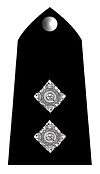 | 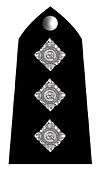 |  |  |
| Rank insignia from the "A Fresh Start" initiative, 1987 | ||||||
| Rank | Prison Officer | Senior Officer | Principal Officer | |||
| Insignia 1987 to 2000 |  |  |  | The Chief Officer grades were abolished and replaced with junior Governor grades. | ||
| Revised rank insignia with LIDS code and unique identification numbers, introduced in 2000 | ||||||
| Rank | Operational Support Grade (OSG) | Prison Officer | Senior Officer | Principal Officer | (Specialist Officer) | |
| Insignia 2000 to 2013 |  |  | 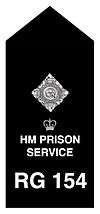 |  | Additionally authorised letters could be used to indicate specialist functions: DH - dog handler W - works officer H - healthcare officer | |
| Current rank insignia introduced from April 2013 | ||||||
| Rank | Operational Support Grade (OSG) | Prison Officer | Supervising Officer | Custodial Manager | (Specialist Officer) | |
| Insignia from 2013 |  | 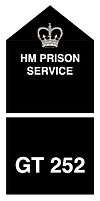 | 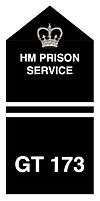 |  | Specialist Officers have role identification letters on their epaulettes: DH - dog handler W - works officer H - healthcare officer | |
Specialist roles
In addition to uniformed officers carrying out security and custodial roles, a number of specialist functions exist within every prison. Some are assigned to uniformed Specialist Officers, whilst others are carried out by non-uniformed support staff.
Before the "Fresh Start" initiative of the mid-1980s there were more uniformed specialist officer roles, including dog handlers, works officers, hospital officers, catering officers, physical education officers, and officer instructors. Today the uniformed Specialist Officer roles include dog handlers (DH), works officers (W), and healthcare officers (H) who are the successors of the former hospital officers. The roles of the former catering officers, PE officers, and officer instructors are today taken by non-uniformed caterers, PE instructors, and educational/vocational instructors.[26]
Other key non-uniformed roles within the staff of a prison include chaplains, psychologists, and administrators.[26]
Private prisons
The Prison Service does not manage all prisons within England and Wales. Currently there are eleven prisons that have been designed, constructed, managed and financed (so-called DCMF prisons) privately. In addition, three prisons that were built with public money are managed by private companies under contract. During 2012 one further prison opened under private sector management: HMP Oakwood (Featherstone 2), built by the public sector. Private prisons are subject to scrutiny by Her Majesty's Chief Inspector of Prisons in a similar manner to prisons run by the public Prison Service.
Ban on industrial action
Questions were raised about the POA's status in the 1990s. In 1994, a legal decision determined that it was illegal to induce prison officers to take industrial action - a law which had applied to police officers since 1919 - meaning that the POA could not call strike action amongst its members. New labour legislation introduced by the Conservative government in 1992 laid down that the POA could no longer be a trade union. This was reversed in the Criminal Justice and Public Order Act of 1994, but prison officers were still denied the right to take industrial action. This right was restored in 2004 to prison officers in the public sector in England, Wales and Scotland, but not in Northern Ireland or to prison officers in the private sector.
On 29 August 2007, the POA started a 24-hour walkout of prisons, picketing establishments asking Prison Officers not to attend work for their shift. This was the first ever national strike action taken by the POA. The POA reported that 90% of its members (27,000) went on strike that day.
In January 2008, the Home Secretary announced that the government was to introduce legislation to remove the right for Prison Officers in England and Wales to take strike action.[27] In November 2016, the High Court approved a Government request to stop industrial action taking place.[28]
Independent Monitoring Board
Every prison and immigration removal centre has an Independent Monitoring Board (IMB), formerly known as a Board of Visitors. Members of the IMB, who are volunteers, are appointed by the Home Secretary and act as 'watchdogs' for both the Minister of Prisons and the general public, to ensure that proper standards of care and decency are maintained.[29]
HMPS in the National Offender Management Service
On 6 January 2004, then Home Secretary David Blunkett announced that the Prison Service, together with the National Probation Service, is to be integrated into a new National Offender Management Service. The Service, Blunkett said, will be "a new body to provide end-to-end management of all offenders".
On 1 April 2008, NOMS was reorganised as part of a shake-up in the Ministry of Justice. The headquarters and regional structures of NOMS and HMPS were merged into a single HQ structure with Phil Wheatly as Director General of NOMS. This brings HMPS and the National Probation Service under a single headquarters structure for the first time ever.[30]
On 1 June 2011, NOMS was merged with the wider MoJ (HMCTS etc.) to form one organisation. Although HMCTS and NOMS are working under different terms and conditions, they are now managed together and HR is dealt with by one Shared Service centre. A review of terms and conditions for all MoJ staff, including NOMS, is currently in progress with view to bringing all staff terms and conditions across NOMS and HMCTS in line.
Old prisons
The Prison Governors Association said:
The old Victorian prisons are squalid and vermin-infested and governors do not have direct access to the funds to tackle it. Prison cells have been vandalised and prisoners have access to drugs and mobile phones, some delivered by drones. [The PGA feared Pentonville's management or a junior member of staff would be scapeegoated over a prison escape but the “finger of blame” should point at the government.] The fact is that there is a complete disconnect between the operational frontline and the policymakers, and countless warnings that the system was creaking was not acted on. It is with profound sincerity [they hope] that the following prediction is wrong but this feels very much like on the beginning of the things to come.[31]
Old prisons are also more expensive to run and do not facilitate rehabilitation of prisoners. Newer prisons can, "design out the dark corners which too often facilitate violence and drug-taking."[32]
See also
Her Majesty's prison service collection is held at the Galleries of Justice Museum in Nottingham.
- Her Majesty's Inspectorate of Prisons
- Her Majesty's Young Offender Institution
- HM Prison
- List of United Kingdom prisons
- Northern Ireland Prison Service
- OASys
- Prison categories in the United Kingdom
- Scottish Prison Service
- United Kingdom prison population
- Young offender
References
- ↑ "HM Prison Service Headquarters". insidetime & insideinformation. 2015. Retrieved 10 November 2015.
- ↑ "Contact us". HM Prison Service. Archived from the original on 17 June 2009. Retrieved 13 February 2010.
HM Prison Service Headquarters Cleland House Page Street London, SW1P 4LN.
- ↑ "Performance ratings". hmprisonservice.gov.uk. Archived from the original on 26 July 2009.
- ↑ "Prison population figures: 2016". justice.gov.uk. Retrieved 30 June 2016.
- ↑ Doward, Jamie. "Rolf Harris leaves behind gilded lifestyle for vulnerable prison unit". The Guardian. Retrieved 10 November 2015.
- ↑ Prisons 'overhaul' announced by David Cameron
- ↑ Alan Travis (18 March 2015). "UK justice minister 'complacent' over 38% rise in prison deaths, say MPs". The Guardian. Retrieved 17 November 2016.
- ↑ "Prisons: planning and policies" (PDF). House of Commons Justice Committee. UK Parliament. 18 March 2015. HC 309. Retrieved 17 November 2016.
- ↑ Alan Travis, Steven Morris (29 April 2014). "Prisons governors ordered to cut costs by £149m a year". The Guardian. Retrieved 17 November 2016.
- 1 2 "Prisons to get 'biggest overhaul in a generation'". BBC News. 3 November 2016. Retrieved 17 November 2016.
- ↑ Britain’s jails are crowded because half the prisoners shouldn’t be there
- 1 2 3 Prison violence in England and Wales up yet again BBC
- 1 2 3 Prisons 'in worst state for a decade', inspector warns BBC
- ↑ Are prisons becoming more dangerous places? BBC
- 1 2 Prisons now unacceptably violent, says watchdog BBC
- ↑ How did Britain's prison system get so bad - and who is to blame? The Independent
- ↑ Prison suicides in England and Wales 'reach record levels' BBC
- ↑ Prisons to get 'biggest overhaul in a generation' BBC
- ↑ Prisons in England and Wales 'need to improve rehabilitation rates' BBC
- ↑ Alan Travis (27 October 2016). "Prison violence epidemic partly due to staff cuts, MoJ admits". The Guardian. Retrieved 17 November 2016.
- ↑ Alan Travis (3 November 2016). "Prisons in England and Wales to get 2,500 extra staff to tackle violence". The Guardian. Retrieved 17 November 2016.
- ↑ Mobile phones in prisons: Why are they still there? BBC
- ↑ Prison governor seriously beaten by inmate
- ↑ Our prisons are dangerous for both staff and inmates. Will Liz Truss's reforms help?
- ↑ "Prison Act 1952 (Section 8)". legislation.gov.uk. 2015. Retrieved 10 November 2015.
- 1 2 "Working for HMPS". UK Government. Retrieved 31 December 2015.
- ↑ "Ministers seek prison strike ban". BBC News. 7 January 2008. Retrieved 10 November 2015.
- ↑ "High court orders prison officers to end protest and go back to work". The Guardian. 15 November 2016. Retrieved 24 November 2016.
- ↑ "Independent Monitoring Boards". imb.org.uk. 2015. Retrieved 10 November 2015.
- ↑ "National Offender Management Service". justice.gov.uk. Retrieved 10 November 2015.
- ↑ Two prisoners escape from Pentonville as governors warn of growing jail crisis The Guardian
- ↑ Prison building revolution announced by Chancellor and Justice Secretary
External links
- HM Prison Service—Ministry of Justice
- Official website (Archive)
- Press release from Home Office about re-organisation
- Prison Officer blog
- Prison Officer learning program
.svg.png)